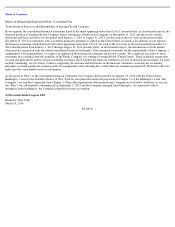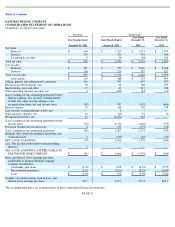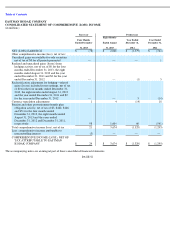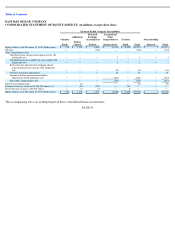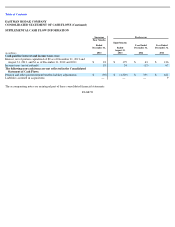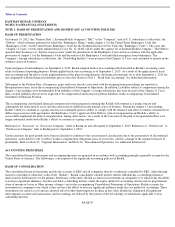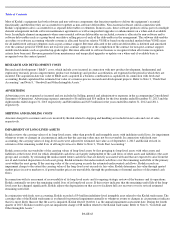Kodak 2013 Annual Report Download - page 63
Download and view the complete annual report
Please find page 63 of the 2013 Kodak annual report below. You can navigate through the pages in the report by either clicking on the pages listed below, or by using the keyword search tool below to find specific information within the annual report.
Table of Contents
EASTMAN KODAK COMPANY
NOTES TO FINANCIAL STATEMENTS
NOTE 1: BASIS OF PRESENTATION AND SIGNIFICANT ACCOUNTING POLICIES
BASIS OF PRESENTATION
On January 19, 2012 (the “Petition Date”), Eastman Kodak Company (“EKC” or the “Company”) and its U.S. subsidiaries (collectively, the
“Debtors”) filed voluntary petitions for relief (the “Bankruptcy Filing”) under chapter 11 of the United States Bankruptcy Code (the
“Bankruptcy Code”) in the United States Bankruptcy Court for the Southern District of New York (the “Bankruptcy Court”). The cases (the
“Chapter 11 Cases”) were jointly administered as Case No. 12-10202 (ALG) under the caption “In re Eastman Kodak Company.” The Debtors
operated their businesses as “debtors-in-possession” under the jurisdiction of the Bankruptcy Court and in accordance with the applicable
provisions of chapter 11 of the Bankruptcy Code and the orders of the Bankruptcy Court until their emergence from bankruptcy. The
Company’s foreign subsidiaries (collectively, the “Non-Filing Entities”) were not part of the Chapter 11 Cases, and continued to operate in the
ordinary course of business.
Upon emergence from bankruptcy on September 3, 2013, Kodak adopted fresh-start accounting which resulted in Kodak’s becoming a new
entity for financial reporting purposes. Kodak applied fresh start accounting as of September 1, 2013. As a result of the application of fresh
start accounting and the effects of the implementation of the plan of reorganization, the financial statements on or after September 1, 2013 are
not comparable with the financial statements prior to that date. Refer to Note 3, “Fresh Start Accounting” for additional information.
Subsequent to the Petition Date, all expenses, gains and losses directly associated with the reorganization proceedings are reported as
Reorganization items, net in the accompanying Consolidated Statement of Operations. In addition, Liabilities subject to compromise during the
chapter 11 proceedings were distinguished from liabilities of the Company’s foreign subsidiaries that were not part of the Chapter 11 Cases,
fully-secured liabilities that were not expected to be compromised and from post-petition liabilities in the accompanying Consolidated
Statement of Financial Position.
The accompanying consolidated financial statements have been prepared assuming that Kodak will continue as a going concern and
contemplate the realization of assets and the satisfaction of liabilities in the normal course of business. During the chapter 11 proceedings,
Kodak’s ability to continue as a going concern was contingent upon its ability to comply with the financial and other covenants contained in its
debtor-in-possession credit agreements, the Bankruptcy Court’s approval of the Debtors’ plan of reorganization and Kodak’s ability to
successfully implement the plan of reorganization, among other factors. As a result of the execution of the plan of reorganization there is no
longer substantial doubt about Kodak’s ability to continue as a going concern.
References to “Successor” or “Successor Company” relate to Kodak on and subsequent to September 1, 2013. References to “Predecessor” or
“Predecessor Company” refer to Kodak prior to September 1, 2013.
Certain amounts for prior periods have been reclassified to conform to the current period classification due to the presentation of discontinued
operations, assets held for sale, to reflect workers compensation obligations gross of recoveries, and for a change in the segment measure of
profitability. Refer to Note 25, “Segment Information” and Note 26, “Discontinued Operations” for additional information.
ACCOUNTING PRINCIPLES
The consolidated financial statements and accompanying notes are prepared in accordance with accounting principles generally accepted in the
United States of America. The following is a description of the significant accounting policies of Kodak.
BASIS OF CONSOLIDATION
The consolidated financial statements include the accounts of EKC and all companies directly or indirectly controlled by EKC, either through
majority ownership or otherwise (collectively “Kodak”). Kodak consolidates variable interest entities if Kodak has a controlling financial
interest and is determined to be the primary beneficiary of the entity. Kodak accounts for investments in companies over which it has the ability
to exercise significant influence, but does not hold a controlling interest, under the equity method of accounting, and records its proportionate
share of income or losses in Other income (charges), net in the accompanying Consolidated Statements of Operations. Kodak accounts for
investments in companies over which it does not have the ability to exercise significant influence under the cost method of accounting. These
investments are carried at cost and are adjusted only for other-than-temporary declines in fair value. Kodak has eliminated all significant
intercompany accounts and transactions, and net earnings are reduced by the portion of the net earnings of subsidiaries applicable to non-
controlling interests.
PAGE 59


